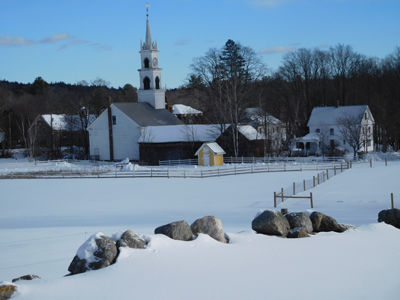The village of Tamworth from the pastures of the Remick Farm
By Gordon DuBois
Throughout the world ancient forests are disappearing, being devastated by man, for economic gain. These age-old forests are being destroyed every day to supply cheap lumber, paper, pulp and palm oil to the world. Thousands of acres are cut daily, extinguishing the last remnants of woodlands that in some cases are more than 1,000 years old. In the United States, pockets of ancient forests have been protected from the modern industrial machine. Forests have been preserved in our National Parks and Monuments, state forests and parks. Private individuals, conservation groups and nonprofit agencies such as the Nature Conservancy have played a major role in preservation of our ancient woods. These protected forests can be found throughout the United States: the giant sequoia in California, the redwoods in Oregon, the bristle cone pine in California, the cypress in Florida.
Here in New Hampshire we have our own protected ancient forests, small but worthy of protection: the red spruce in Nancy Pond Natural Area, pitch pine-scrub oak in the Ossipee Pine Barrens, hemlock in Chesterfield Gorge and Pisgah State Park and black gum. The black gum tree is apparently the longest-lived broadleaf deciduous tree in North America. Six sites have been documented in New Hampshire that have black gum trees older than 500 years, with the oldest individual at one of these sites exceeding 679 years in Rockingham County.
Close to the Lakes Region is the Big Pines Natural Area of the Hemenway State Forest. These 108 acres of protected forest represents one of the last visages of the old growth forests of white pine that covered the northeastern United States. Within the past 200 years, most of the forestland has been cut for farming and logging. For some unknown reason this stand and others in the northeast escaped the woodsman's ax. These behemoths have not only withstood the colonial mast trade, but the great lumbering era, survived the great hurricane of 1938, disease, rot and invasive pests.
For many years I had driven by the Hemenway State Forest. It had always been of interest to me. Then a friend suggested a hike through the woodland and I accepted. I started the hike with several other hiking companions at the Big Pines trail head, off route 113A in Tamworth. When we entered the Hemenway State Forest I was struck by the towering and immense stand of white pines that have been around for more than 200 years. Hemlocks 250 to 300 years also grow here. The trail was well packed and it was an easy stroll with micro spikes, stopping to admire the many gigantic pines, some more than 150 feet in height. We craned our necks looking toward the sky, trying to see the upper reaches of these trees. We stopped in front of one monstrous white pine and were awestruck by the circumference of the trunk. We then made a chain of human hands around the tree and it took 5 of us to totally encircle the tree, amazing.
We continued our walk through the ancient forest and then began the ascent of Tower Hill, a steep climb to this height of land with views of the surrounding terrain. A fire tower graces the summit, still maintained by the Tamworth Conservation Commission. We climbed to the top of the tower and entered the fire warden's cabin to find spectacular views of the Ossipee and Sandwich Mountain Ranges. In the distance, Whiteface, Passaconaway, Square Ledge and Chocorua gleamed in the bright sun.
As I gazed at Chocorua, with its distinctive summit, I thought of the Native American legend, "The Curse of Chocorua." As legend has it, in 1720 Chocorua, a native chief, was on friendly terms with settlers and in particular the Campbell family that had a home in the village now called Tamworth. Chocorua was called away and left his son in the care of the Campbell family, early settlers in the village. Chocorua's son found and drank a poison that Mr. Campbell had made to eliminate troublesome foxes. When Chocorua returned he found his son had died of the poison. Chocorua, distraught with grief, pledged revenge on the Campbell family. Shortly thereafter, Mr. Campbell returned home one afternoon to find his wife and children had been slain. Campbell suspected Chocorua and pursued him up the mountain that today bears his name. Chocorua was wounded by a shot from Campbell's musket. Before Campbell could reach Chocorua, he uttered a curse upon the white settlers and their homes, livestock, and crops, and leapt from the summit to his death, screaming these words, "May the Great Spirit curse you when he speaks in the clouds and his words are fire! Lightning blast your crops! Wind and fire destroy your homes! The Evil One breathe death on your cattle! Panthers howl and wolves fatten on your bones!" Given the fact that many early settlers, tired of trying to farm the rock-laden soil, left New Hampshire to find more fertile land further west. Most certainly they sensed the curse of Chocorua.
With that I mind I hustled down the tower and we began our trek back to the highway. We took a side path that led us along a nature trail which identified particular plants and trees of along the pathway. The total distance of this hike was two miles. This would make a terrific outing for a family. The trail is easy to follow as it winds its way through the Big Pines, and eventually leads to Tower Hill with its eponymous fire tower.
Following our exit of the Hemenway State Forest, we made our way back to Tamworth for a respite at the Other Store on Main Street. This general store is very welcoming and sells everything from ice cream to snow shovels, from nails to post cards. We stopped in the store and were greeted by Andrea Kennet, who offered us hot soup and sandwiches. We had lunch, chatted briefly with town folk, learning more about the store and the history of the town. This is one of those quintessential New England towns that appear on the Currier and Ives pictures we see in Yankee Magazine.
Following our lunch we made our way over to the Remick Country Doctor Museum and Farm. We found the farm museum closed, but took advantage of a trail that winds around the property. While walking this trail we found striking views of the farm and Tamworth Village along with Mount Chocorua in the far distance.
Located on Cleveland Hill Road in the center of Tamworth village, this working farm was the home of the Remick family since 1790. Dr. Edwin Remick and his son Dr. Edwin "Doc" Crafts Remick, lived and practiced medicine on the farm for a combined 99 years, serving the rural population of Tamworth and the surrounding area. The museum and farm are open year round, but the best time to visit is during the summer when the livestock – goats, pigs, chickens, sheep and dairy cows – are grazing in the pastures and willing to greet visitors, especially children. Special programs are offered year-round. If you are interested in learning more about this unique New Hampshire institution check out their web site, remickmuseum.org.
You can find Gordon and his dog Reuben exploring the many hiking trails in the Lakes Region and beyond. He can be reached at forestpd@metrocast.net
Fire tower at summit of Tower HillRemick Farm



















(0) comments
Welcome to the discussion.
Log In
Keep it Clean. Please avoid obscene, vulgar, lewd, racist or sexually-oriented language.
PLEASE TURN OFF YOUR CAPS LOCK.
Don't Threaten. Threats of harming another person will not be tolerated.
Be Truthful. Don't knowingly lie about anyone or anything.
Be Nice. No racism, sexism or any sort of -ism that is degrading to another person.
Be Proactive. Use the 'Report' link on each comment to let us know of abusive posts.
Share with Us. We'd love to hear eyewitness accounts, the history behind an article.